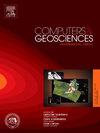Quantitative lithology prediction from seismic data using deep learning
IF 4.4
2区 地球科学
Q1 COMPUTER SCIENCE, INTERDISCIPLINARY APPLICATIONS
引用次数: 0
Abstract
Lithology prediction is essential for understanding subsurface structures and properties. Deep learning (DL) methods, which can capture the nonlinear relationship between lithology and seismic data, have gained significant attention as an effective tool in lithology prediction. However, these methods still face many challenges such as limited well-log data, class imbalances, and the need for robust predictive models. To address these issues, we propose an adaptive boosting-convolutional neural network (AdaBoost-CNN) framework integrated with improved inverse spectral decomposition (ISD) based on non-convex L1-2 regularization. The ISD method generates high-resolution time-frequency (T-F) spectral maps from seismic data, which serve as inputs for the CNN. Furthermore, we introduce an enhanced sample weight adjustment strategy and a "CNN transfer" mechanism within the AdaBoost framework to address class imbalance and enhance training efficiency. The performance of AdaBoost–CNN was validated through field cases, and a comprehensive evaluation of the model parameters was conducted to understand their impact on performance. Field experiments demonstrated that the proposed method enhanced both the training efficiency and generalization ability of the models. Additionally, it effectively predicted lithology from seismic data and quantified lithology probabilities, thereby providing insights into the distribution of subsurface lithology.
利用深度学习技术对地震数据进行定量岩性预测
岩性预测是了解地下结构和性质的基础。深度学习(DL)方法作为一种有效的岩性预测工具,能够捕捉岩性与地震数据之间的非线性关系,受到了广泛关注。然而,这些方法仍然面临许多挑战,如有限的测井数据、类不平衡以及对稳健预测模型的需求。为了解决这些问题,我们提出了一个自适应增强卷积神经网络(AdaBoost-CNN)框架,该框架集成了基于非凸L1-2正则化的改进逆频谱分解(ISD)。ISD方法从地震数据中生成高分辨率时频(T-F)频谱图,作为CNN的输入。此外,我们在AdaBoost框架中引入了增强的样本权值调整策略和“CNN迁移”机制,以解决类不平衡问题,提高训练效率。通过现场案例验证AdaBoost-CNN的性能,并对模型参数进行综合评估,了解其对性能的影响。现场实验表明,该方法提高了模型的训练效率和泛化能力。此外,它还可以有效地从地震数据中预测岩性并量化岩性概率,从而深入了解地下岩性的分布。
本文章由计算机程序翻译,如有差异,请以英文原文为准。
求助全文
约1分钟内获得全文
求助全文
来源期刊

Computers & Geosciences
地学-地球科学综合
CiteScore
9.30
自引率
6.80%
发文量
164
审稿时长
3.4 months
期刊介绍:
Computers & Geosciences publishes high impact, original research at the interface between Computer Sciences and Geosciences. Publications should apply modern computer science paradigms, whether computational or informatics-based, to address problems in the geosciences.
 求助内容:
求助内容: 应助结果提醒方式:
应助结果提醒方式:


